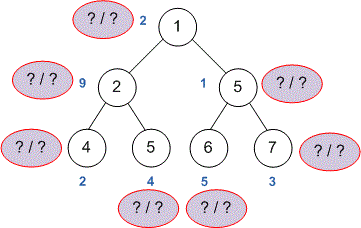Redaksiya
Let be a vertex of the tree. Let's define:
as the maximum sum of coins that can be collected from the subtree rooted at if we take the coins in vertex .
as the maximum sum of coins that can be collected from the subtree rooted at if we do not take the coins in vertex .
Then the answer to the problem will be , assuming the first vertex is taken as the root of the tree.
Let’s define the given functions recursively:
If we take the coins in vertex , then we cannot take coins from its children:
If we do not take the coins in vertex , then we can choose either to take or not take coins from its children. We select the option with the maximum sum of coins:
If is a leaf with coins, then the functions take the following values: and .
Example
Let's assign the labels to the vertices of the trees from the examples.

For the first example, we have:
;
;
;
;
For the second example, we have:
;
;
;
;
Exercise
Assign the labels to the vertices of the tree:

Algorithm realization
Declare the arrays.
vector<vector<int> > g; vector<int> dp1, dp2, cost;
The dfs function implements depth-first search. Compute the values of and at all vertices of the tree.
void dfs(int v, int p = -1)
{
dp1[v] = cost[v];
dp2[v] = 0;
for (int to : g[v])
{
if (to == p) continue;
dfs(to, v);
dp1[v] += dp2[to];
dp2[v] += max(dp1[to], dp2[to]);
}
}The main part of the program. Read the tree and the array of coins.
scanf("%d",&n);
g.resize(n+1);
for(i = 1; i < n; i++)
{
scanf("%d %d",&u,&v);
g[u].push_back(v);
g[v].push_back(u);
}
dp1.resize(n+1); dp2.resize(n+1);
cost.resize(n+1);
for(i = 1; i <= n; i++)
scanf("%d",&cost[i]);Let the root of the tree be at vertex . Start the depth-first search from there.
dfs(1);
Compute and print the answer.
ans = max(dp1[1], dp2[1]);
printf("%d\n",ans);